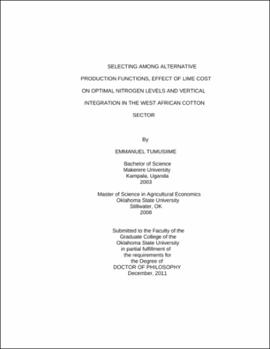| dc.contributor.advisor | Brorsen, B. Wade | |
| dc.contributor.author | Tumusiime, Emmanuel | |
| dc.date.accessioned | 2013-11-26T08:22:06Z | |
| dc.date.available | 2013-11-26T08:22:06Z | |
| dc.date.issued | 2011-12 | |
| dc.identifier.uri | https://hdl.handle.net/11244/6546 | |
| dc.description.abstract | Scope and Method of Study: | |
| dc.description.abstract | This dissertation consists of three essays: The first essay determines the optimal level of N fertilizer for rye-ryegrass pasture using yield functions estimated with different functional forms that assume parameters are either nonstochastic or stochastic. Three yield functions were estimated: linear response plateau, quadratic, and Spillman-Mitscherlich. | |
| dc.description.abstract | The second paper determines the effect of considering the cost of lime on recommendations about optimal levels of N. Yield response and soil pH change functions were estimated and used to determine the optimal levels of N and lime. The study also developed a new version of a linear response plateau function that allows the yield plateau to vary by year with respect to nitrogen but not soil pH. | |
| dc.description.abstract | The third paper provides an economic explanation of the existence of parastatal vertical integration market structures in the cotton sector of West Africa, and contrasts it with other market structure alternatives in terms of welfare and sector efficiency. | |
| dc.description.abstract | Findings and Conclusions: | |
| dc.description.abstract | In the first essay, nonstochastic models are rejected in favor of stochastic parameter models. The stochastic models lead to smaller recommended levels of N, but the economic benefits of using fully stochastic models are small since expected profit functions are relatively flat for the stochastic models. | |
| dc.description.abstract | In the second essay, considering the cost of lime reduced the optimal level of N by as much as 11.3%. Acidification potential due to N fertilizer increased nonlinearly as N rate increased. N acidification appears to be more severe with N application rates above consumptive potential of the crop than with N that is used by the plant. | |
| dc.description.abstract | In the third essay, due to credit and or factor market constraints, vertical integrated cotton parastatals increase sector welfare and efficiency by supplying inputs to overcome credit constraints. Surplus sharing between the grower and the integrator is significantly shifted towards the cotton company. Removing the integrated cotton parastatals in favor of a free market structures would result in little cotton being produced. | |
| dc.format | application/pdf | |
| dc.language | en_US | |
| dc.rights | Copyright is held by the author who has granted the Oklahoma State University Library the non-exclusive right to share this material in its institutional repository. Contact Digital Library Services at lib-dls@okstate.edu or 405-744-9161 for the permission policy on the use, reproduction or distribution of this material. | |
| dc.title | Selecting among alternative production functions, effect of lime cost on optimal nitrogen levels and vertical integration in the West African cotton sector | |
| dc.contributor.committeeMember | Epplin, Francis | |
| dc.contributor.committeeMember | Biermacher, Jon | |
| dc.contributor.committeeMember | Vitale, Jeffrey | |
| dc.contributor.committeeMember | Zhang, Hailin | |
| osu.filename | Tumusiime_okstate_0664D_11587.pdf | |
| osu.accesstype | Open Access | |
| dc.type.genre | Dissertation | |
| dc.type.material | Text | |
| thesis.degree.discipline | Agricultural Economics | |
| thesis.degree.grantor | Oklahoma State University | |
